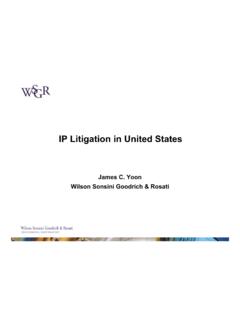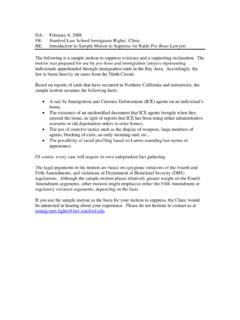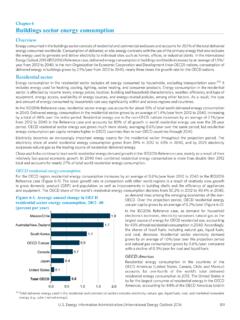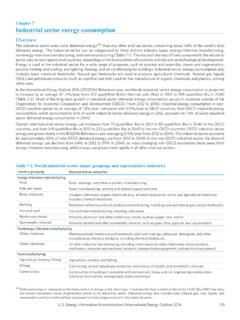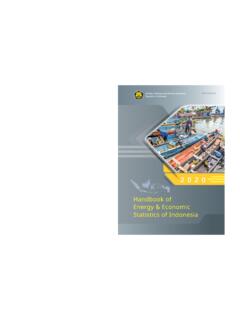Transcription of Electricity Consumption and Economic Growth: A New ...
1 Electricity Consumption andEconomic growth : A NewRelationship with SignificantConsequences?The growth rate of Electricity Consumption has importantimplications for business and public policy. This articledescribes altered trends in the relationship betweengrowth in Economic activity and Electricity use and offershypotheses to explain them. These new trends requireutility system stakeholders to rethink old assumptions andprepare for a new reality of lower growth rates inelectricity F. Hirsh and Jonathan G. KoomeyI. IntroductionThe growth rate of electricityconsumption has importantimplications for business andpublic policy.
2 Increasing use ofelectricity usually boostspower producers income, butconstruction of conventionalgenerating plants to meet risingdemand may add to pollution andother environmental woes. Thetraditional electric utility businessmodel is predicated oncontinuously expanding usage ofelectricity, and if the rate ofgrowth slows (or becomesnegative), profits will decline,especially if companies buildunneeded generating Consumption is alsoembedded as a key element in theRichard F. Hirshis a professor ofHistory and Science & TechnologyStudies at Virginia Tech; he employssocial-science approaches to helpunderstand events in the electric powersystem.
3 His books includeTechnologyand Transformation in the AmericanElectric Utility IndustryandPowerLoss: Deregulation andRestructuring in the AmericanElectric Utility a newproject, Hirsh is reinterpreting thestandard narrative of ruralelectrification, concluding that utilitycompanies (along with partners in land-grant colleges) actually pursuedsignificant work to power up farms beforethe Great Depression. He holds a the History of Science and an inPhysics from the University G. Koomeyis a ResearchFellow at the Steyer-Taylor Center forEnergy Policy and Finance at StanfordUniversity. For more than two decades,he worked at Lawrence Berkeley NationalLaboratory and has been a visitingprofessor at Stanford University, YaleUniversity and UC Berkeley s Energyand Resources Group.
4 He was also alecturer in management at Stanford sGraduate School of Business. holds and degreesfrom the Energy and Resources Group atUC Berkeley and an in History andScience from Harvard University. He isone of the leading international expertson the economics of reducing greenhousegas emissions, the effects of informationtechnology on resource use, and theenergy use and economics of data authors are grateful for theconsiderable and generous suggestionsmade by John A. Skip Laitner, JimMcMahon, Mark Levine, and #2015 Elsevier Inc. All rights reserved., Electricity JournalObama administration s CleanPower Plan.
5 If the actual growthrate differs from the forecastamount, then perverse andunexpected outcomes can particular, lower-than-predicted Consumption growthwould imply less-stringentenvironmental mitigationrequirements than article explores therelationship betweenelectricity use and economicactivity since 1949. Thatrelationship has been a majordriver of Electricity forecasts inthe past, and it continues to holdsway today. But the relationshiphas changed significantly in the time of the first oilshock in the early 1970s, the shifted from a period ofelectrification and increasingelectricity intensity to one inwhich Electricity use and grossdomestic product (GDP) grew atcomparable rates.
6 Then, in themid-1990s, the economyentered a period in whichelectricity Consumption grewmore slowly than the , since 2007, the has generated GDPgrowth with almost no net growthin Electricity demand. If this lasttrend continues, it will presentfundamental challenges to howutilities operate in the , withimplications for the design ofpublic policies that affectcreation of new generationresources, energy efficiency, andcompliance with ElectricityConsumption andEconomic ActivityDo Electricity Consumption andeconomic well-being go hand-in-hand? For decades, conventionalwisdom (and data) answered thisquestion with a resounding yes.
7 A 1960 article celebratingThomas Edison s birthdayobserved, for example, that thepower industry is a growthindustry in the fullest sense of thatterm! Electricity increasinglystimulates over-all economicgrowth in the United 3 That belief held sway into the1980s, as the solid connectionbetween prosperity and electricityconsumption implied that theeconomy cannot grow at a ratemuch higher than the rate ofincrease in the electricitysupply. 4 The Department ofEnergy and several electric utilityorganizations published apamphlet in 2003 noting that the use of Electricity has growndramatically over the last 30 yearsand mirrors the equally robustgrowth of the gross domesticproduct (GDP), the gauge ofeconomic health in the UnitedStates.
8 5In 2007, the EdisonElectric Institute, a trade group ofelectric utility companies, ob-served in its publication (avail-able online in 2011 or later),KeyFacts About the Electric Power In-dustry, that [e]lectricity is thelifeblood of the economy 6and that [g]rowth in electricityuse has coincided with growth inthe GDP since the end of WorldWar II. 7 The apparently strongrelationship betweeneconomic growth and electricityconsumption often motivates theneed for increased power-plantconstruction, at least in the eyes ofsome utility stakeholders. Economic growth is good newsfor Virginia, noted DominionVirginia Power s Web site in 2011,for example, but it presentsspecial challenges due to theprojected increase in electricitydemand of almost 4,500 MW inthe next decade that may resultfrom the rising GDP.
9 A strongeconomy requires more energy tosupport its continued growth , the site declared. The key issueconfronting the Commonwealthis where the additional power willcome from to sustain thisgrowth. 8 For planning purposes,the company develops forecaststhat correlate strongly witheconomic measures; its 2010integrated resource planningdocument noted that the forecastof the Virginia economy drove theCompany s energy sales and loadA solid connectionbetween prosperity andelectricity consumptionimplied that theeconomy cannot growat a rate much higherthan the rate of increasein the electricitysupply.
10 November 2015,Vol. 28, Issue 91040-6190/#2015 Elsevier Inc. All rights reserved., 9 More recently, thefirm s 2014 plan, which usesseveral models and considers ahost of variables, still notes thatthe forecast for the Virginiaeconomy is a key driver in theCompany s energy sales and loadforecasts. 10 And while itconsiders many factors, the PJMI nterconnection, the regional gridoperator for 13 states (and theDistrict of Columbia), stillemploys projections of economicgrowth for determining cannot dispute the notionthat Electricity use has yieldedhuge productivity enhancementsthat benefit the economy (and willlikely continue to do so), nor thateconomic growth in the past haspropelled increased electricityuse.

